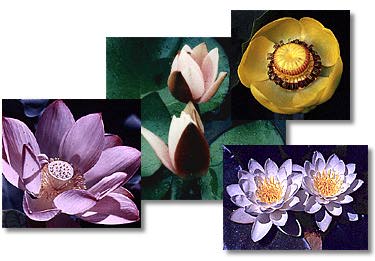







In either case, the Nymphaeales are certainly an early group. One line of evidence to support this is that they carry a mix of traits normally not found together in the same plant. Specifically, they have traits of both monocots and dicots, the two groups into which flowering plants may be divided. Apparently, waterlilies evolved before the separation of these two great evolutionary lines. Waterlilies have the stem anatomy of dicots, with an organized ring of vascular tissue, while they have the plastid anatomy of monocots. Some species of the genus Nymphaea even have what looks like a single cotyledon.

The images above illustrate some of the diversity of waterlilies. At left is Nelumbo (lotus); at top right is Nuphar polysepalum; at bottom right is Nymphaea alba; and at center are the unopened blossoms of an unidentified species of Nymphaea growing in the Budapest botanical gardens.
There is no universally accepted classification of all waterlilies, though one popular system divides the living species into four families:
Family descriptions have been made available for Barclayaceae, Cabombaceae, Nelumbonaceae, and Nymphaeaceae as part of the DELTA Project.
Visit the Tree of Life for current views on the relationships of Nymphaeales.

Sources:
M.W.Chase, et al., 1993. Phylogenetics of seed plants: An analysis of nucleotide
sequences from the plastid gene rbcL. Ann. Missouri Bot. Gard. 80: 528-580.
S. Magallón, P. R. Crane, & P. S. Herendeen, 1999. Phylogenetic Pattern, Diversity, and Diversification of Eudicots. Ann. Missouri Bot. Gard. 86(2):297- 372.

